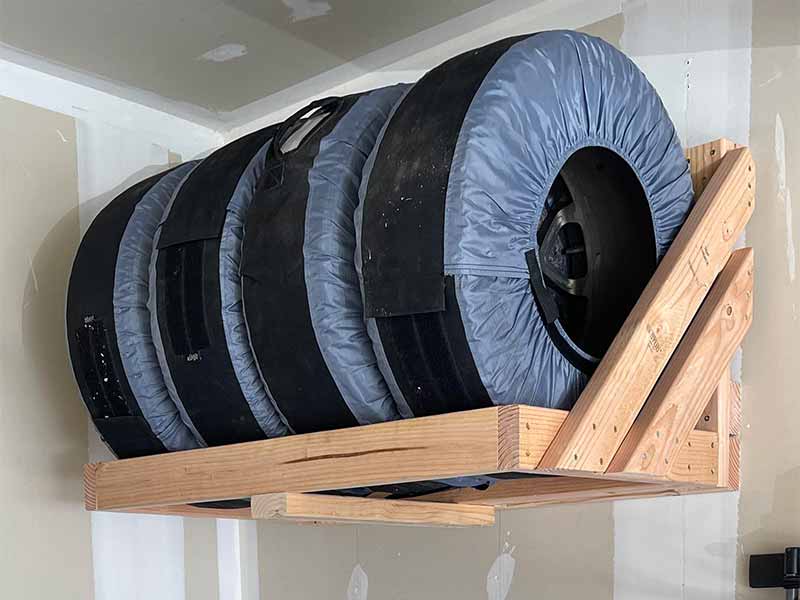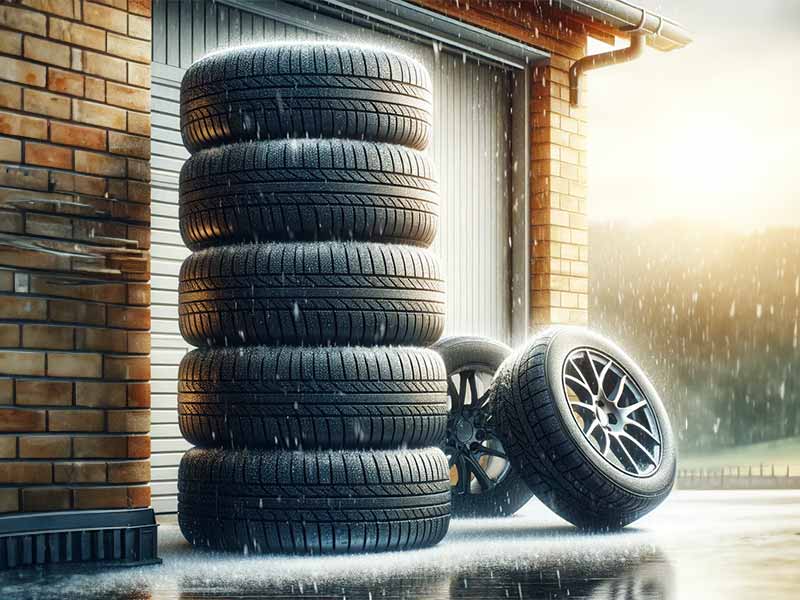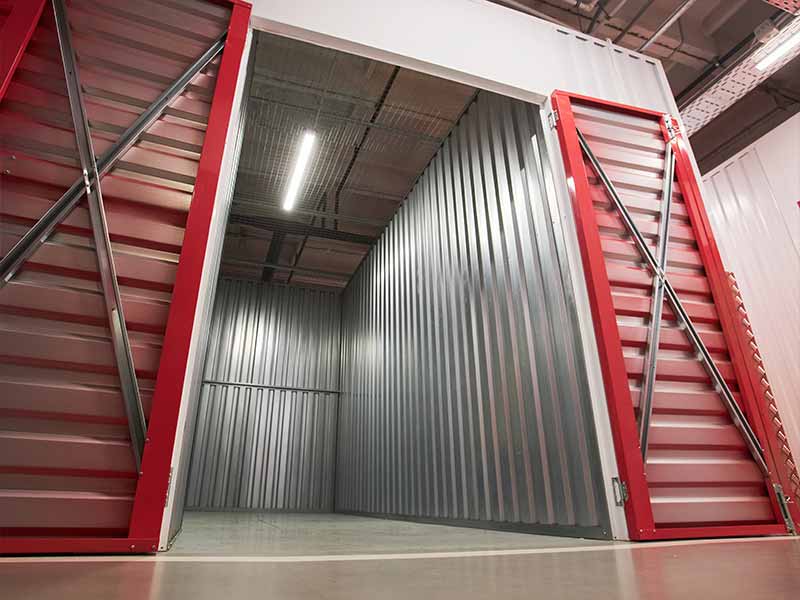Imagine you’re ready to switch out your winter tires and ponder where to keep the off-season set. The attic seems like an out-of-the-way spot, but is it the right place for something as crucial as your tires?
Can You Store Tires In The Attic?
Storing tires in the attic is generally not recommended due to extreme temperature fluctuations and potential humidity, which can significantly degrade tire quality and safety.
In this article, we will discuss the composition of tires, why and how the attic environment affects them, guidelines for storing tires long term, and practical tips to prevent tire deterioration.

Pros and Cons Of Storing Tires In An Attic
Deciding if the attic is the right place for your tires requires a good look at the potential benefits and drawbacks. Attics are convenient, out-of-the-way places, but they come with their own set of challenges, especially when it comes to temperature control.
The Attic Environment
Before you haul your tires up those attic stairs, consider what they’ll be facing:
- Temperature Fluctuations: Attics can become extremely hot in summer and cold in winter.
- Humidity Levels: Varies widely, can lead to moisture buildup or excessive dryness.
- Ventilation: Often limited, affecting temperature and humidity control.
Impact of Seasonal Changes on Tires
In Summer:
- Excessive Heat: Can accelerate the aging process of the tires, causing the rubber to become brittle and crack.
- High Humidity: May introduce moisture, leading to potential mildew or other moisture-related issues.
In Winter:
- Extreme Cold: While less damaging than heat, can make tires brittle and potentially cause cracking, especially when moved or if they bear weight.
Weighing the Pros and Cons
Pros:
- Out of the way: Attics provide a space that’s typically unused, keeping your tires out of your immediate living or working space.
- Large space: Can accommodate multiple sets of tires if needed.
Cons:
- Temperature Extremes: Can significantly shorten the life of your tires.
- Accessibility: Retrieving tires from an attic, especially in different seasons, can be a hassle and potentially dangerous.
If you don’t have much room at home, a conditioned storage unit could be ideal.
TireGrades Expert Tip
How Long Can You Store Tires in the Attic?
When considering storing tires in the attic, a critical question pops up: just how long can they last up there? The answer isn’t straightforward as it depends on various factors, including the attic’s conditions and how well the tires are prepared for storage. Here’s what you need to know to make an informed decision.
Factors Affecting Tire Lifespan in Storage
- Temperature Consistency: Fluctuations can speed up the aging process.
- Humidity Control: Excess moisture or dryness can lead to deterioration.
- Sunlight Exposure: UV rays can weaken the rubber compounds.
- Positioning: How tires are stored (e.g., stacked, standing) can affect their shape and structure.
Setting Realistic Timeframes
Given the attic’s typically harsh conditions, here’s a rough guide:
- Short-Term Storage (up to 3 months): Possible if the attic’s conditions are moderated somewhat, but not ideal.
- Long-Term Storage (3 months to a year or more): Not recommended due to the high likelihood of irreversible damage from temperature extremes and humidity issues.
Tips for Maximizing Tire Life in Storage
If you decide to use the attic for short-term storage or have no other option, consider these tips to help extend the life of your tires:
- Temperature Control: Try to minimize temperature fluctuations if possible.
- Humidity Regulation: Use dehumidifiers or other means to control moisture levels.
- Avoid Sunlight: Keep tires away from windows or any direct light source.
- Proper Positioning: Store tires vertically on tire racks if possible, and avoid stacking them directly on the ground.

How to Store Tires Long Term
Storing tires for an extended period requires careful consideration to ensure they remain in good condition when it’s time to use them again. Whether you’re swapping out seasonal tires or holding onto a spare set, understanding the best practices for long-term storage can significantly extend their lifespan and maintain their performance. Here are the key strategies to keep in mind.
Preparing Tires for Storage
- Clean Them First: Remove dirt, grime, and brake dust to prevent decay.
- Dry Thoroughly: Any moisture can lead to mildew or other issues.
- Inspect for Damage: Address any issues before storing to avoid surprises later.
Ideal Storage Conditions
- Cool, Dry, and Dark: Protects against the biggest threats: heat, humidity, and sunlight.
- Moderate Temperature: Ideally, keep the storage area consistently between 50°F and 77°F.
- Away from Ozone: Electric motors and certain devices can produce ozone, which degrades tire rubber.
Storing the Tires
- Vertically on Racks: Best for maintaining shape, especially if they’re on rims.
- Avoid Stacking: If necessary, rotate the stack periodically to prevent deformation.
- Covered: Use tire bags or wraps to protect from dust and ozone.
Monitoring and Maintenance
- Check Periodically: Look for any signs of damage or environmental changes.
- Maintain Inflation (if on rims): Follow manufacturer recommendations for any adjustments.

Airtight Tire Storage Bags
How to Prevent Tire Deterioration
Maintaining the condition of your tires during storage is crucial for ensuring they perform as expected when you need them. Deterioration can lead to safety issues and unexpected costs. This section outlines strategies to prevent common forms of tire damage such as dry rot, cracking, and deformation.
Understanding Tire Deterioration
First, let’s understand what we’re up against:
- Dry Rot: Caused by heat, oxygen, and time, leading to brittle, cracked rubber.
- Deformation: Can occur from improper storage or pressure.
- Chemical Breakdown: The tire’s components can break down due to environmental conditions.
Strategies for Prevention
Implementing these strategies can significantly reduce the risk of tire deterioration:
Environmental Control:
- Temperature: Store tires away from areas with large temperature swings. Ideal conditions are cool, dry, and dark.
- Humidity: Keep it stable and moderate. Too much moisture leads to mildew and too little can dry out the tires.
- Sunlight: Avoid UV exposure as it can accelerate the breakdown of rubber compounds.
Physical Care:
- Clean Before Storing: Remove oils, road salts, or other materials that can degrade rubber.
- Inflate Properly: If tires are mounted on rims, maintain the recommended pressure to help them retain shape.
- Positioning: Store tires vertically on tire racks to prevent flat spots and deformation. Rotate them occasionally if stacked.
Regular Inspections:
- Visual Checks: Look for any signs of cracking, bulging, or other visible damage.
- Pressure Checks: For mounted tires, periodically check and adjust pressure.
- Rotate and Reposition: If stored for an extended time, reposition the tires to prevent stress on any one part.

Specific Seasonal Considerations
Storing tires is not a one-size-fits-all process. The season during which you store your tires can significantly impact their condition and lifespan. Understanding how to adjust your storage methods for winter and summer conditions is crucial. Here are some seasonal considerations to keep in mind to ensure your tires remain in optimal condition all year round.
Summer Storage Considerations
The heat of summer presents unique challenges for tire storage:
- Heat Mitigation: Attics and garages can become extremely hot. Look for the coolest, most stable environment possible.
- Ventilation: Ensure good airflow in the storage area to prevent heat buildup.
- Sunlight Protection: Even indirect sunlight can increase temperature and cause UV damage. Keep tires away from windows or areas with sunlight exposure.
Winter Storage Considerations
Cold temperatures also require special attention:
- Cold Resistance: While tires are less likely to degrade in cold, extreme cold can make rubber brittle. Avoid unheated outdoor sheds or garages if temperatures dip significantly.
- Moisture Control: Winter can bring dampness. Ensure your storage area remains dry to prevent mold or mildew.
- Rodent Protection: Small critters look for warm places in the winter. Ensure tires are stored off the ground and in a way that prevents nesting.
Adjusting Storage Practices
Based on these considerations, here are some tips for adjusting your tire storage with the seasons:
In Summer:
- Increased Inspections: Check on your tires more frequently for signs of heat damage.
- Reposition More Often: To avoid any one area getting too much exposure to heat or light.
- Consider a Climate-Controlled Space: If feasible, this can greatly reduce the risk of heat damage.
In Winter:
- Elevate Tires: Keep them off cold floors which can promote flat spots and cracking.
- Cover Tires: Use breathable covers to protect from dust and dirt, but still allow moisture escape.
- Check Environment Regularly: Ensure the storage area remains dry and free from drastic temperature changes.
Electrical equipment can produce ozone which will damage tire rubber.
TireGrades Expert Tip
Common Mistakes to Avoid in Tire Storage
When it comes to storing tires, a few common missteps can lead to unnecessary wear and tear or even render your tires unsafe for future use. Being aware of these pitfalls and knowing how to avoid them can save you time, money, and hassle in the long run. Let’s explore the most frequent mistakes people make and how to steer clear of them.
Overlooking Environmental Conditions
- Ignoring Temperature Fluctuations: Storing tires in places with significant temperature swings, like an attic or an unregulated garage, can accelerate aging.
- Neglecting Humidity Levels: Both excessive moisture and dryness can damage tires.
- Exposing Tires to Direct Sunlight: UV rays can degrade the rubber even if you don’t see immediate damage.
Improper Storage Position
- Stacking for Long Periods: While it might save space, stacking tires without periodically rotating them can cause the tires at the bottom to deform.
- Leaving Tires Mounted on Vehicles: If you’re storing a seasonal vehicle, prolonged periods of inactivity can cause flat spots on the tires.
- Failing to Inflate Correctly: Under-inflated or over-inflated tires can lose their shape or suffer internal damage while in storage.
Neglecting Tire Preparation
- Not Cleaning Tires Before Storage: Dirt, oils, and other substances can break down the rubber over time.
- Skipping Inspections: Small issues can turn into big problems if tires aren’t regularly checked for damage, pressure, or wear.
- Forgetting About Age: Even unused, tires have a lifespan. Old tires might not be safe even if they look okay.
Avoiding these common storage mistakes:
Environmental Control:
- Choose the Right Spot: A climate-controlled, dry, and dark space is ideal for tire storage.
- Monitor Conditions: Regularly check the temperature and humidity of your storage area.
Proper Positioning:
- Use Tire Racks: If possible, keep tires vertical and off the ground.
- Rotate Stacked Tires: If you must stack, rotate them occasionally to relieve pressure.
- Maintain Pressure: If tires are on rims, keep them properly inflated even in storage.
Regular Maintenance:
- Clean and Dry: Make sure tires are spotless and completely dry before storage.
- Regular Checks: Even in storage, inspect your tires periodically for signs of damage or wear.
- Mind the Age: Remember that tires have a “best before” date, typically around 5-10 years from manufacture, even if unused.
Resources
Below are some links you may find helpful when learning about tires
- How to help prevent tire dry rot – Goodyear
- Storing tires – How to store tires correctly – Continental Tires
Final Thoughts
When considering storing tires, especially in areas like the attic, it’s crucial to weigh the pros and cons. The article aimed to provide a comprehensive guide on how to store tires effectively while avoiding common mistakes that could lead to tire deterioration.
The key takeaways are understanding the impact of temperature, humidity, and positioning on your tires’ health. For the best outcome, always consider a cool, dry, and dark environment for storage.
Good luck and happy motoring.





